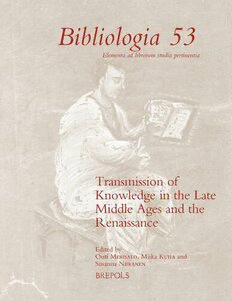
Transmission of Knowledge in the Late Middle Ages and the Renaissance (Bibliologia) (English, French and Italian Edition) (Bibliologia: Elementa Ad Librorum Studia Pertinentia, 53) PDF
240 Pages·2019·2.626 MB·English
Most books are stored in the elastic cloud where traffic is expensive. For this reason, we have a limit on daily download.
Preview Transmission of Knowledge in the Late Middle Ages and the Renaissance (Bibliologia) (English, French and Italian Edition) (Bibliologia: Elementa Ad Librorum Studia Pertinentia, 53)
Description:
The nineteenth century saw the rapid development of textual criticism for establishing the best and most authentic forms of both Ancient and Mediaeval texts thanks to the method perfected by Karl Lachmann, who based himself on the insights gained during the eighteenth century. Lachmann's method has been further refined by later philologists, with, most interestingly, the use of computers in establishing the mutual relations of manuscript witnesses since the last decades of the twentieth century. However, the interest in what form the texts, both Ancient and Mediaeval, were actually circulating in the Late Middle Ages and in the Renaissance, has been slow to emerge as an area of scholarly interest. In other words: what did the readers actually get in front of their eyes, and acted upon as, say, doctors, historians, theologians between the thirteenth and sixteenth centuries? This volume explores the Late Medieval and Renaissance transmission of texts of different genres, languages and periods from the book historical point of view, taking into consideration not only the textual but also the material aspect of the traditions. The authors include eminent specialists as well as mid- and early career scholars.
See more
The list of books you might like
Most books are stored in the elastic cloud where traffic is expensive. For this reason, we have a limit on daily download.
